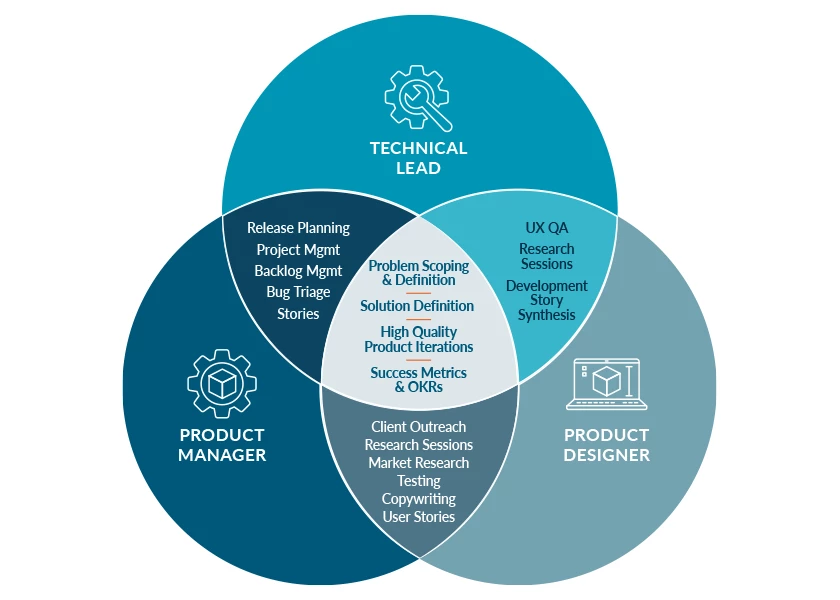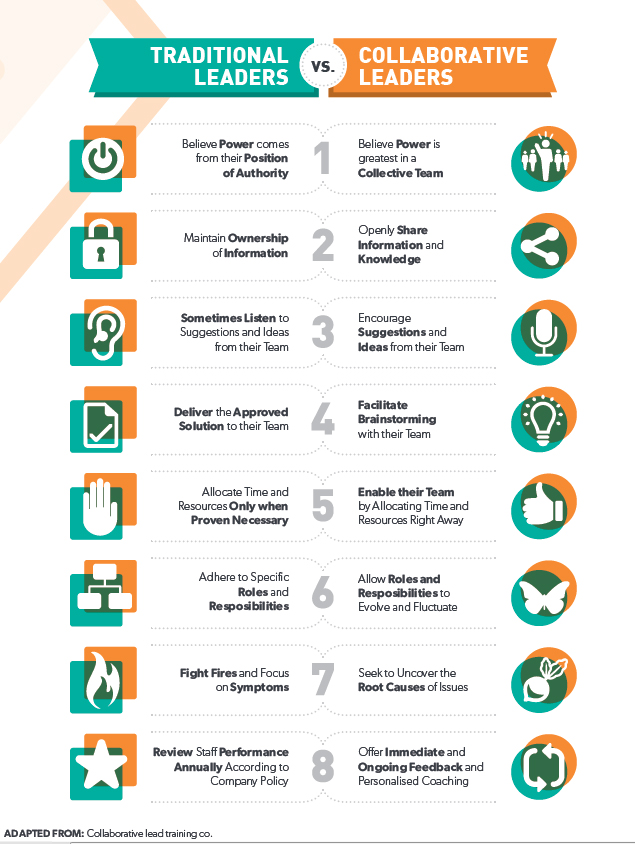Guest Post: Collaborative Leadership Is More Than Just Brainstorming And Feedback Sessions
Copperleaf®practices collaborative leadership to ensure its teams are empowered, high-functioning, and productive. Over the last several months, I’ve been working with Copperleaf to develop a workshop on collaborative leadership. In this article, I’ll highlight what collaborative leadership is, how to practice it, and why it’s important.
When making decisions about the product roadmap, Copperleaf creates multi-skilled leadership teams, called triads, made up of representatives from design (who are also responsible for user research), development (engineering), and product management. Ideally, these triads work in a collaborative way, led by different individuals at different times based on needs, responsibilities, expertise, and bandwidth.
The following model shows the three roles and their areas of sole and shared responsibility. This model, with some variation in the specifics, is what’s used in many modern digital product development organizations. It’s used at Copperleaf because it’s not only highly effective, but also aligns with several core values: to be collaborative, open, and agile. It also supports Copperleaf’s values of continuous improvement and delivering exceptional value, because a high-functioning team is always learning from its members and that drives high-quality solutions.

Most of the time, the triads work wonderfully, with an easy ebb and flow, robust ideation, and a well-managed workflow. Leadership balance isn’t always equal—it may pull to one side or the other, but as long as the balance is dynamic and the team remains in alignment, the triangle holds its shape. But then sometimes it doesn’t…because, well, we’re human. One side of the triad either gets too big or pulls too hard, alignment fails, and the triangle collapses.
In my work with various teams, when things fall apart, it’s not because of bad intent. That is, no one is trying to pull the team out of alignment. It’s often because there’s not a clear understanding of how to work on an empowered team.
According to this article by Forbes, leadership is about influence and impact:
Leadership is a process of social influence, which maximizes the efforts of others, towards the achievement of a goal.
Forbes
The ability to influence others therefore requires a great deal of teamwork and collaboration—not just brainstorming and feedback.
A Model for Collaborative Leadership
At the beginning of our collaborative leadership workshop, we showed this diagram:
It’s been somewhat controversial:
-
Some people see it as a set up. They feel like we’re saying collaborative leadership is better than traditional leadership. There’s a sense that if leadership is about decisions, then you need authority and ownership to lead. So how can that be collaborative?
-
Some people feel that sometimes it’s important to be more of a traditional leader and the diagram doesn’t reflect this continuum. They feel like certain situations require leaders to take more control because there’s not always enough time to encourage suggestions or facilitate brainstorming. How can collaborative leadership work within a time-challenged environment?
-
Some people feel like, “we don’t need this, we already collaborate.” They have the impression that since brainstorming and feedback happen, what more is there to talk about? Are there times where collaboration is more important than others?
These comments are all valid. They reflect the fluidity of where management (guiding people towards a particular vision or goal) ends, and leadership (creating the vision and motivating people towards it) begins. The aim of introducing this diagram is to encourage curiosity about how to lead in a collaborative way and create a follow-on plan that people have contributed to and are excited about.
A Story About the Beginnings of a Project…
To explore how collaborative leadership works (or doesn’t) we created a true but fictional story about the beginnings of a project:
-
Harry Potter, a Copperleaf employee, learns about a problem that he’s been asked to solve with his team. Yes! That’s what he does best!
-
He calls a meeting with his triad (Ron and Hermione) stating the name of the problem in the subject line.
-
It takes a couple of days to get everyone together, so Harry spends that time researching and thinking about the problem.
-
When it comes time for the meeting, Harry presents the problem and then shares his solution, and asks for feedback and ideas.
-
He leaves the meeting frustrated because he got a lot of pushback, spent way too much time explaining, and can’t figure out why the team is dragging him down.
-
The team leaves the meeting feeling frustrated and unsure what to do next. No next steps were set and an exciting and valuable problem to solve has now lost its shine and momentum.
What could Harry have done better? If Harry wanted to be a more collaborative leader, there were improvements he could’ve made at every step:
-
Instead of taking the meeting alone, he could have invited some or all of his team to the initial meeting (as optional).
-
Instead of providing only the name of the problem in the meeting invitation, he could have provided more background info.
-
Instead of focusing on the solution, he could have taken the time to better prepare for the meeting by doing things like preparing an agenda and thinking about ways to engage the team.
-
Instead of asking for feedback on his solution, he could have spent time reframing and understanding the problem, checking for alignment and buy-in, and ideating and collaborating on potential solutions.
-
Instead of walking away feeling frustrated, he could have made sure everyone had a clear sense of next steps and felt good about where things netted out.
I know I’ve behaved like Harry before and likely will again. It’s human to want to jump to a solution. And when the stress, or in this case excitement, about solving a new problem arises, it’s all too natural to feel the need to take more control. It’s also common to feel resentful when you don’t feel heard and therefore put up walls instead of staying open. We all, at times, slip out of that collaborative mindset. It takes practice and mindfulness to keep a team in a collaborative state.
Wait, what about Ron and Hermione?
On an empowered team, we all have a voice. When one person is pulling the dynamic out of whack, it’s important to help the team restore balance. So how could Hermione and Ron have helped Harry?
-
While there’s nothing they can do about something they don’t know about, they can encourage trust and sharing by being open and letting Harry know that they share his goals.
-
When they received the email invite, they could have asked for more information about the problem and where to go to learn more.
-
They could have helped Harry by suggesting an agenda, sharing additional resources with the team, and/or suggesting a reframing exercise.
-
If Harry presented a solution and requested feedback, they could have asked to slow things down to make space for reframing, or used the feedback session to build on Harry’s ideas.
-
Instead of dismissing Harry’s ideas, they could have had a conversation with Harry about how they don’t feel heard and why that’s a problem.
How you show up is your responsibility and that includes how you respond to others. If someone is showing up in a less collaborative way, the rest of the team (including you!) needs to help pull that person back into alignment.
Of course, none of this is easy. As I said earlier, it takes practice and mindfulness. It’s important to tune into how you are showing up as a leader AND how you are showing up as a follower.
In Conclusion
Collaborative leadership has been proven to foster a thriving team environment and help create higher levels of trust between colleagues. Effective collaboration is important for any organization, but it’s especially important in the tech world because it helps create a working environment that encourages people to pursue creative and innovative solutions.
Team empowerment and openness are important parts of our culture. Learn more about what it’s like working at Copperleaf and how we support our people.


